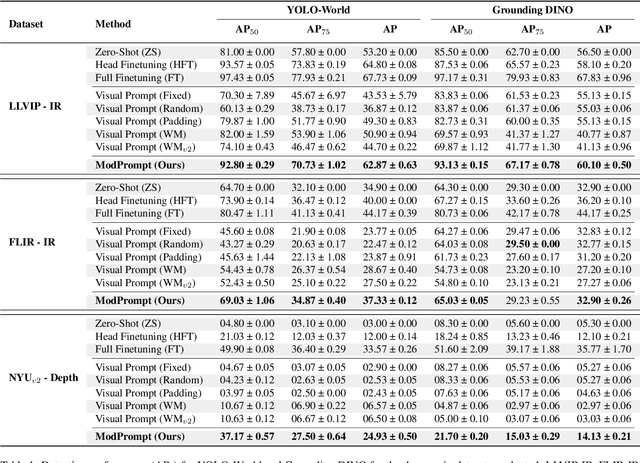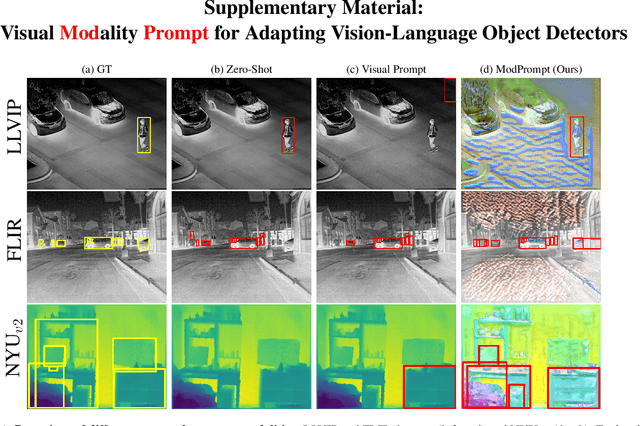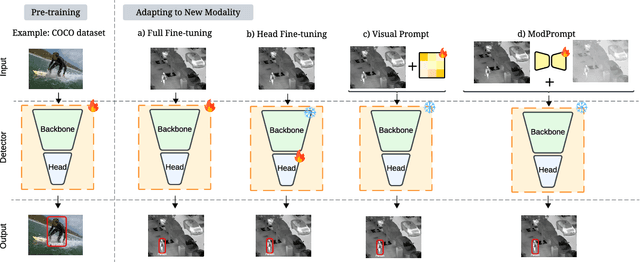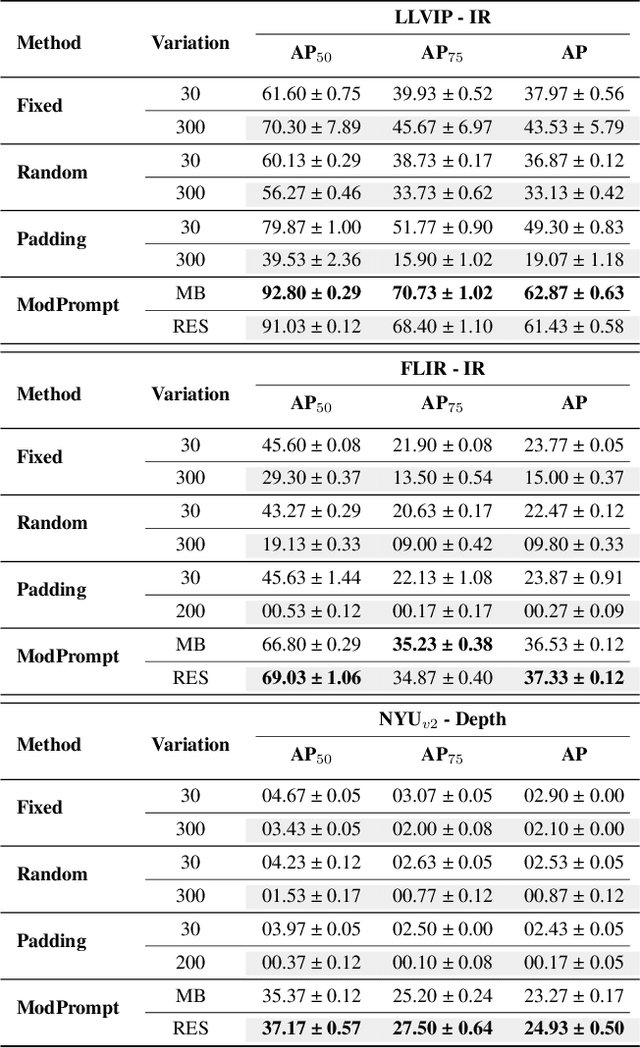Eric Granger
LIVIA ILLS Dept. of Systems Engineering ETS Montreal Canada
BAH Dataset for Ambivalence/Hesitancy Recognition in Videos for Behavioural Change
May 25, 2025Abstract:Recognizing complex emotions linked to ambivalence and hesitancy (A/H) can play a critical role in the personalization and effectiveness of digital behaviour change interventions. These subtle and conflicting emotions are manifested by a discord between multiple modalities, such as facial and vocal expressions, and body language. Although experts can be trained to identify A/H, integrating them into digital interventions is costly and less effective. Automatic learning systems provide a cost-effective alternative that can adapt to individual users, and operate seamlessly within real-time, and resource-limited environments. However, there are currently no datasets available for the design of ML models to recognize A/H. This paper introduces a first Behavioural Ambivalence/Hesitancy (BAH) dataset collected for subject-based multimodal recognition of A/H in videos. It contains videos from 224 participants captured across 9 provinces in Canada, with different age, and ethnicity. Through our web platform, we recruited participants to answer 7 questions, some of which were designed to elicit A/H while recording themselves via webcam with microphone. BAH amounts to 1,118 videos for a total duration of 8.26 hours with 1.5 hours of A/H. Our behavioural team annotated timestamp segments to indicate where A/H occurs, and provide frame- and video-level annotations with the A/H cues. Video transcripts and their timestamps are also included, along with cropped and aligned faces in each frame, and a variety of participants meta-data. We include results baselines for BAH at frame- and video-level recognition in multi-modal setups, in addition to zero-shot prediction, and for personalization using unsupervised domain adaptation. The limited performance of baseline models highlights the challenges of recognizing A/H in real-world videos. The data, code, and pretrained weights are available.
DART$^3$: Leveraging Distance for Test Time Adaptation in Person Re-Identification
May 23, 2025Abstract:Person re-identification (ReID) models are known to suffer from camera bias, where learned representations cluster according to camera viewpoints rather than identity, leading to significant performance degradation under (inter-camera) domain shifts in real-world surveillance systems when new cameras are added to camera networks. State-of-the-art test-time adaptation (TTA) methods, largely designed for classification tasks, rely on classification entropy-based objectives that fail to generalize well to ReID, thus making them unsuitable for tackling camera bias. In this paper, we introduce DART$^3$, a TTA framework specifically designed to mitigate camera-induced domain shifts in person ReID. DART$^3$ (Distance-Aware Retrieval Tuning at Test Time) leverages a distance-based objective that aligns better with image retrieval tasks like ReID by exploiting the correlation between nearest-neighbor distance and prediction error. Unlike prior ReID-specific domain adaptation methods, DART$^3$ requires no source data, architectural modifications, or retraining, and can be deployed in both fully black-box and hybrid settings. Empirical evaluations on multiple ReID benchmarks indicate that DART$^3$ and DART$^3$ LITE, a lightweight alternative to the approach, consistently outperforms state-of-the-art TTA baselines, making for a viable option to online learning to mitigate the adverse effects of camera bias.
CLIP-IT: CLIP-based Pairing for Histology Images Classification
Apr 22, 2025Abstract:Multimodal learning has shown significant promise for improving medical image analysis by integrating information from complementary data sources. This is widely employed for training vision-language models (VLMs) for cancer detection based on histology images and text reports. However, one of the main limitations in training these VLMs is the requirement for large paired datasets, raising concerns over privacy, and data collection, annotation, and maintenance costs. To address this challenge, we introduce CLIP-IT method to train a vision backbone model to classify histology images by pairing them with privileged textual information from an external source. At first, the modality pairing step relies on a CLIP-based model to match histology images with semantically relevant textual report data from external sources, creating an augmented multimodal dataset without the need for manually paired samples. Then, we propose a multimodal training procedure that distills the knowledge from the paired text modality to the unimodal image classifier for enhanced performance without the need for the textual data during inference. A parameter-efficient fine-tuning method is used to efficiently address the misalignment between the main (image) and paired (text) modalities. During inference, the improved unimodal histology classifier is used, with only minimal additional computational complexity. Our experiments on challenging PCAM, CRC, and BACH histology image datasets show that CLIP-IT can provide a cost-effective approach to leverage privileged textual information and outperform unimodal classifiers for histology.
Learning from Stochastic Teacher Representations Using Student-Guided Knowledge Distillation
Apr 19, 2025Abstract:Advances in self-distillation have shown that when knowledge is distilled from a teacher to a student using the same deep learning (DL) architecture, the student performance can surpass the teacher particularly when the network is overparameterized and the teacher is trained with early stopping. Alternatively, ensemble learning also improves performance, although training, storing, and deploying multiple models becomes impractical as the number of models grows. Even distilling an ensemble to a single student model or weight averaging methods first requires training of multiple teacher models and does not fully leverage the inherent stochasticity for generating and distilling diversity in DL models. These constraints are particularly prohibitive in resource-constrained or latency-sensitive applications such as wearable devices. This paper proposes to train only one model and generate multiple diverse teacher representations using distillation-time dropout. However, generating these representations stochastically leads to noisy representations that are misaligned with the learned task. To overcome this problem, a novel stochastic self-distillation (SSD) training strategy is introduced for filtering and weighting teacher representation to distill from task-relevant representations only, using student-guided knowledge distillation (SGKD). The student representation at each distillation step is used as authority to guide the distillation process. Experimental results on real-world affective computing, wearable/biosignal datasets from the UCR Archive, the HAR dataset, and image classification datasets show that the proposed SSD method can outperform state-of-the-art methods without increasing the model size at both training and testing time, and incurs negligible computational complexity compared to state-of-the-art ensemble learning and weight averaging methods.
Beyond Patches: Mining Interpretable Part-Prototypes for Explainable AI
Apr 16, 2025Abstract:Deep learning has provided considerable advancements for multimedia systems, yet the interpretability of deep models remains a challenge. State-of-the-art post-hoc explainability methods, such as GradCAM, provide visual interpretation based on heatmaps but lack conceptual clarity. Prototype-based approaches, like ProtoPNet and PIPNet, offer a more structured explanation but rely on fixed patches, limiting their robustness and semantic consistency. To address these limitations, a part-prototypical concept mining network (PCMNet) is proposed that dynamically learns interpretable prototypes from meaningful regions. PCMNet clusters prototypes into concept groups, creating semantically grounded explanations without requiring additional annotations. Through a joint process of unsupervised part discovery and concept activation vector extraction, PCMNet effectively captures discriminative concepts and makes interpretable classification decisions. Our extensive experiments comparing PCMNet against state-of-the-art methods on multiple datasets show that it can provide a high level of interpretability, stability, and robustness under clean and occluded scenarios.
PixelCAM: Pixel Class Activation Mapping for Histology Image Classification and ROI Localization
Mar 31, 2025Abstract:Weakly supervised object localization (WSOL) methods allow training models to classify images and localize ROIs. WSOL only requires low-cost image-class annotations yet provides a visually interpretable classifier, which is important in histology image analysis. Standard WSOL methods rely on class activation mapping (CAM) methods to produce spatial localization maps according to a single- or two-step strategy. While both strategies have made significant progress, they still face several limitations with histology images. Single-step methods can easily result in under- or over-activation due to the limited visual ROI saliency in histology images and the limited localization cues. They also face the well-known issue of asynchronous convergence between classification and localization tasks. The two-step approach is sub-optimal because it is tied to a frozen classifier, limiting the capacity for localization. Moreover, these methods also struggle when applied to out-of-distribution (OOD) datasets. In this paper, a multi-task approach for WSOL is introduced for simultaneous training of both tasks to address the asynchronous convergence problem. In particular, localization is performed in the pixel-feature space of an image encoder that is shared with classification. This allows learning discriminant features and accurate delineation of foreground/background regions to support ROI localization and image classification. We propose PixelCAM, a cost-effective foreground/background pixel-wise classifier in the pixel-feature space that allows for spatial object localization. PixelCAM is trained using pixel pseudo-labels collected from a pretrained WSOL model. Both image and pixel-wise classifiers are trained simultaneously using standard gradient descent. In addition, our pixel classifier can easily be integrated into CNN- and transformer-based architectures without any modifications.
MTLoc: A Confidence-Based Source-Free Domain Adaptation Approach For Indoor Localization
Mar 18, 2025Abstract:Various deep learning models have been developed for indoor localization based on radio-frequency identification (RFID) tags. However, they often require adaptation to ensure accurate tracking in new target operational domains. To address this challenge, unsupervised domain adaptation (UDA) methods have been proposed to align pre-trained models with data from target environments. However, they rely on large annotated datasets from the initial domain (source). Source data access is limited by privacy, storage, computational, and transfer constraints. Although many source-free domain adaptation (SFDA) methods address these constraints in classification, applying them to regression models for localization remains challenging. Indeed, target datasets for indoor localization are typically small, with few features and samples, and are noisy. Adapting regression models requires high-confidence target pseudo-annotation to avoid over-training. In this paper, a specialized mean-teacher method called MTLoc is proposed for SFDA. MTLoc updates the student network using noisy data and teacher-generated pseudo-labels. The teacher network maintains stability through exponential moving averages. To further ensure robustness, the teacher's pseudo-labels are refined using k-nearest neighbor correction. MTLoc allows for self-supervised learning on target data, facilitating effective adaptation to dynamic and noisy indoor environments. Validated using real-world data from our experimental setup with INLAN Inc., our results show that MTLoc achieves high localization accuracy under challenging conditions, significantly reducing localization error compared to baselines, including the state-of-the-art adversarial UDA approach with access to source data.
Image Retrieval Methods in the Dissimilarity Space
Dec 11, 2024Abstract:Image retrieval methods rely on metric learning to train backbone feature extraction models that can extract discriminant queries and reference (gallery) feature representations for similarity matching. Although state-of-the-art accuracy has improved considerably with the advent of deep learning (DL) models trained on large datasets, image retrieval remains challenging in many real-world video analytics and surveillance applications, e.g., person re-identification. Using the Euclidean space for matching limits the performance in real-world applications due to the curse of dimensionality, overfitting, and sensitivity to noisy data. We argue that the feature dissimilarity space is more suitable for similarity matching, and propose a dichotomy transformation to project query and reference embeddings into a single embedding in the dissimilarity space. We also advocate for end-to-end training of a backbone and binary classification models for pair-wise matching. As opposed to comparing the distance between queries and reference embeddings, we show the benefits of classifying the single dissimilarity space embedding (as similar or dissimilar), especially when trained end-to-end. We propose a method to train the max-margin classifier together with the backbone feature extractor by applying constraints to the L2 norm of the classifier weights along with the hinge loss. Our extensive experiments on challenging image retrieval datasets and using diverse feature extraction backbones highlight the benefits of similarity matching in the dissimilarity space. In particular, when jointly training the feature extraction backbone and regularised classifier for matching, the dissimilarity space provides a higher level of accuracy.
Visual Modality Prompt for Adapting Vision-Language Object Detectors
Dec 01, 2024



Abstract:The zero-shot performance of object detectors degrades when tested on different modalities, such as infrared and depth. While recent work has explored image translation techniques to adapt detectors to new modalities, these methods are limited to a single modality and apply only to traditional detectors. Recently, vision-language detectors, such as YOLO-World and Grounding DINO, have shown promising zero-shot capabilities, however, they have not yet been adapted for other visual modalities. Traditional fine-tuning approaches tend to compromise the zero-shot capabilities of the detectors. The visual prompt strategies commonly used for classification with vision-language models apply the same linear prompt translation to each image making them less effective. To address these limitations, we propose ModPrompt, a visual prompt strategy to adapt vision-language detectors to new modalities without degrading zero-shot performance. In particular, an encoder-decoder visual prompt strategy is proposed, further enhanced by the integration of inference-friendly task residuals, facilitating more robust adaptation. Empirically, we benchmark our method for modality adaptation on two vision-language detectors, YOLO-World and Grounding DINO, and on challenging infrared (LLVIP, FLIR) and depth (NYUv2) data, achieving performance comparable to full fine-tuning while preserving the model's zero-shot capability. Our code is available at: https://github.com/heitorrapela/ModPrompt
TD-Paint: Faster Diffusion Inpainting Through Time Aware Pixel Conditioning
Oct 11, 2024Abstract:Diffusion models have emerged as highly effective techniques for inpainting, however, they remain constrained by slow sampling rates. While recent advances have enhanced generation quality, they have also increased sampling time, thereby limiting scalability in real-world applications. We investigate the generative sampling process of diffusion-based inpainting models and observe that these models make minimal use of the input condition during the initial sampling steps. As a result, the sampling trajectory deviates from the data manifold, requiring complex synchronization mechanisms to realign the generation process. To address this, we propose Time-aware Diffusion Paint (TD-Paint), a novel approach that adapts the diffusion process by modeling variable noise levels at the pixel level. This technique allows the model to efficiently use known pixel values from the start, guiding the generation process toward the target manifold. By embedding this information early in the diffusion process, TD-Paint significantly accelerates sampling without compromising image quality. Unlike conventional diffusion-based inpainting models, which require a dedicated architecture or an expensive generation loop, TD-Paint achieves faster sampling times without architectural modifications. Experimental results across three datasets show that TD-Paint outperforms state-of-the-art diffusion models while maintaining lower complexity.
 Add to Chrome
Add to Chrome Add to Firefox
Add to Firefox Add to Edge
Add to Edge